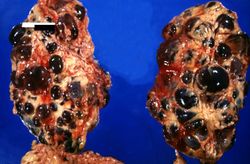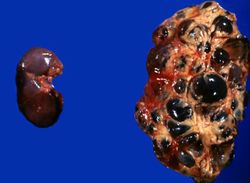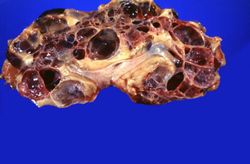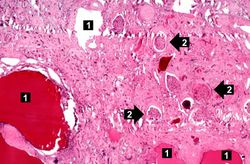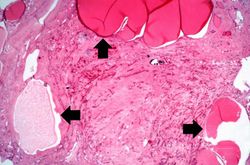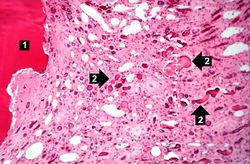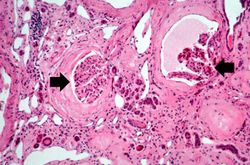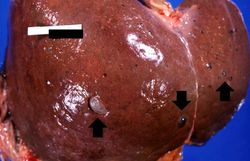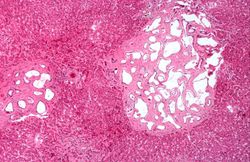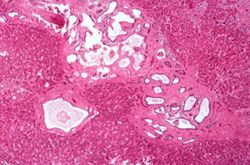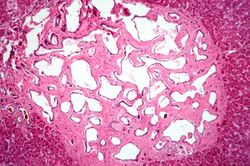Difference between revisions of "IPLab:Lab 5:Polycystic Kidney Disease"
Seung Park (talk | contribs) |
Seung Park (talk | contribs) |
||
| Line 29: | Line 29: | ||
* <spoiler text="What is the significance of history of hypertension and uremic pericarditis in this patient?">People with polycystic kidney disease often develop hypertension, as do many patients with renal disease. Uremic pericarditis often occurs in people with kidney failure induced uremia.</spoiler> | * <spoiler text="What is the significance of history of hypertension and uremic pericarditis in this patient?">People with polycystic kidney disease often develop hypertension, as do many patients with renal disease. Uremic pericarditis often occurs in people with kidney failure induced uremia.</spoiler> | ||
* <spoiler text="What are some of the other congenital anomalies that can be seen in people with polycystic kidney disease?">Asymptomatic polycystic liver disease is seen in 40% of these patients. Cysts can also occur, albeit infrequently, in the spleen, pancreas and lungs. These people also have a 10% to 30% incidence of berry aneurysms in the circle of Willis.</spoiler> | * <spoiler text="What are some of the other congenital anomalies that can be seen in people with polycystic kidney disease?">Asymptomatic polycystic liver disease is seen in 40% of these patients. Cysts can also occur, albeit infrequently, in the spleen, pancreas and lungs. These people also have a 10% to 30% incidence of berry aneurysms in the circle of Willis.</spoiler> | ||
| + | |||
| + | == Additional Resources == | ||
| + | === Reference === | ||
| + | * [http://emedicine.medscape.com/article/244907-overview eMedicine Medical Library: Polycystic Kidney Disease] | ||
| + | * [http://emedicine.medscape.com/article/453831-overview eMedicine Medical Library: Cystic Diseases of the Kidney] | ||
| + | * [http://www.merckmanuals.com/professional/genitourinary_disorders/cystic_kidney_disease/overview_of_cystic_kidney_disease.html Merck Manual: Overview of Cystic Kidney Disease] | ||
| + | |||
| + | === Journal Articles === | ||
| + | * Bajwa ZH, Gupta S, Warfield CA, Steinman TI. [http://www.ncbi.nlm.nih.gov/pubmed/11703580 Pain management in polycystic kidney disease]. ''Kidney Int'' 2001 Nov;60(5):1631-44. | ||
| + | |||
| + | === Images === | ||
| + | * [http://peir.path.uab.edu/library/index.php?/tags/110-polycystic_disease PEIR Digital Library: Polycystic Kidney Disease Images] | ||
| + | * [http://library.med.utah.edu/WebPath/RENAHTML/RENALIDX.html#5 WebPath: Polycystic Kidney Disease] | ||
{{IPLab 5}} | {{IPLab 5}} | ||
[[Category: IPLab:Lab 5]] | [[Category: IPLab:Lab 5]] | ||
Revision as of 13:57, 22 August 2013
Contents
Clinical Summary[edit]
This 64-year-old white man had a history of hypertension, adult-onset diabetes, gouty arthritis, chronic obstructive pulmonary disease (COPD), chronic anemia, bleeding from colonic polyps, and bleeding from gastric ulcers. The patient was in end-stage renal failure due to polycystic kidney disease and he required renal dialysis. His mother and a brother both died from renal complications.
His terminal admission was for congestive heart failure and ventricular tachycardia. He underwent a coronary artery bypass grafting (CABG) operation after which he was ventilator-dependent. Two days after the operation he developed pneumonia and died.
Autopsy Findings[edit]
The lungs were diffusely consolidated with some abscesses in the right upper lobe. The kidneys were markedly enlarged. The right kidney weighed 1660 grams and the left kidney weighted 1780 grams.
Images[edit]
Study Questions[edit]
Additional Resources[edit]
Reference[edit]
- eMedicine Medical Library: Polycystic Kidney Disease
- eMedicine Medical Library: Cystic Diseases of the Kidney
- Merck Manual: Overview of Cystic Kidney Disease
Journal Articles[edit]
- Bajwa ZH, Gupta S, Warfield CA, Steinman TI. Pain management in polycystic kidney disease. Kidney Int 2001 Nov;60(5):1631-44.
Images[edit]
| |||||
Renal failure is the severe reduction of renal function and often leads to reduced urinary output.
In alcoholics, aspiration pneumonia is common--bacteria enter the lung via aspiration of gastric contents.
Consolidation is the filling of lung air spaces with exudate--this is a sign of pneumonia.
An abscess is a collection of pus (white blood cells) within a cavity formed by disintegrated tissue.
A normal kidney weighs 157 grams (range: 115 to 220 grams).
A normal kidney weighs 157 grams (range: 115 to 220 grams).
Pericarditis is inflammation of the pericardium - often with deposition of fibrin.
